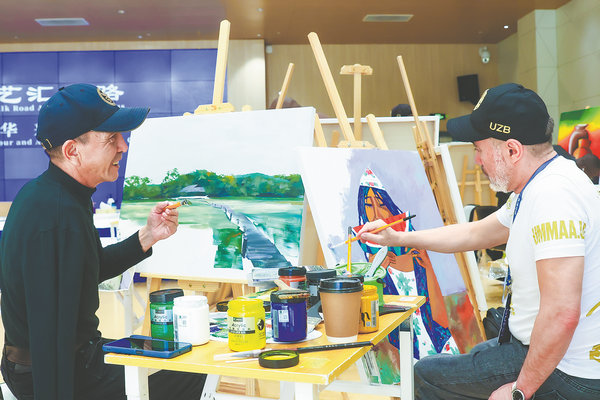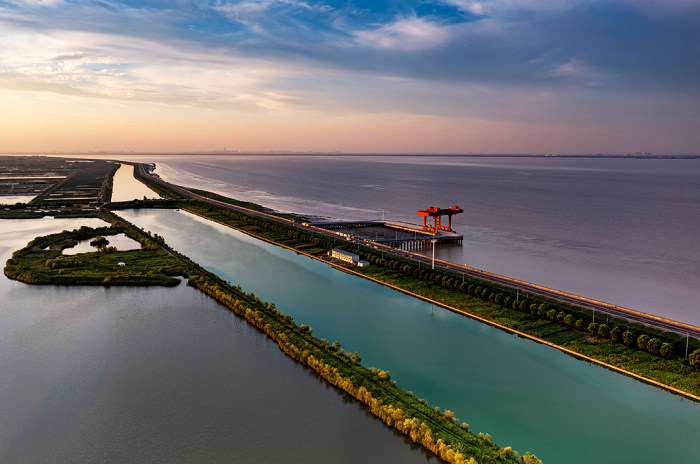Different strokes

Foreign artists paint during their stay in Hangzhou, on the "Silk Road Artists' Rendezvous" program. [Photo provided to China Daily]
An international array of artists experience and get inspired by Hangzhou.
The landscapes and the lively scenes of Hangzhou, Zhejiang province, a fine-tuned combination of the natural and man-made, traditional and modern, have provided a group of foreign artists lavish material for thinking and creating.
Via a weeklong "Silk Road Artists' Rendezvous" program in late November, 84 artists from 83 countries have created works that embody mountains and rivers in and around the city, the green, golden and yellow leaves on the trees glittering in the sun, and the traditional dwellings with white walls and black-tiled roofs, presenting the charm of their elegant simplicity.
Some of them drew inspiration from historical artifacts — jade in particular — found at the Archaeological Ruins of Liangzhu City, a UNESCO World Heritage Site in northwestern Hangzhou that dates back more than 5,000 years, while some cast their eyes on everyday life — the delivery riders and their scooters, snack bars, couples and singletons.
"The artists have connected their own cultural characteristics with Chinese culture and cultivated a wonderful experience," said Yu Xuhong, director of the Art Museum of the China Academy of Art, on a guided tour of an exhibition in Hangzhou on Dec 3, where around 150 pieces created by these artists during the trip were displayed.
Katherine Rose McLeod, from New Zealand, painted in Hangzhou with a local broom, which is very different from the brushes she would normally use.
She watched how the cleaners move with the traditional broom, usually made of bamboo filaments, thatches or sorghum stalk, and applied that method to her creation.
For her, the 10-day trip to Hangzhou was highlighted by Chinese-French painter Zao Wou-ki's works, which are on show at the art museum, titled The Way is Infinite: Centennial Retrospective Exhibition of Zao Wou-Ki.
Zao (1921-2013) studied and taught at the precursor of the academy before settling in France in the late 1940s.
McLeod said: "Visually I could read all that language (of Zao's works), the Chinese roots, and then the breaking free, and the Western references, like that of Pablo Picasso, Paul Cezanne and J.M.W. Turner."
She was so moved by Zao's work, Homage to Francoise-23.10.2003, that she burst into tears in front of it.
"They have an energy. You have to go and see them in person," McLeod said, adding that the progression of Zao's painting style and career led her to reflect on that of her own.
Yu noted that, throughout his life, Zao kept exploring to combine Western artistic language with the Chinese artistic spirit to create really integrated works.
He added that the intuitive expression of Zao through color, shape and the meaning of his pictures is actually a kind of spiritual dialogue between the East and the West, which touched and inspired the foreign artists.
The museum director mentioned Panamanian artist and architect Gabriel Wong's 4-meter-long work Fuchun Rock and Roll, for which the artist, by applying bright colors, created a "hot ink-and-brush painting" — as Wong put it — to infuse the image with a nostalgia for his tropical homeland.
The artist painted a miniature black-and-white version of the work at the same time, a tree with intertwined branches, a waterfall and overlapping peaks vividly conveying a traditional Chinese ink-and-brush temperament.
"Cultural exchanges and mutual learning between civilizations bring profound resources and vigor to the artists' creation. In Chinese culture, they may find alternative ideas and direction for creating," Yu said.
"An important inspiration I've received through this program is seeing how artists from various cultural backgrounds communicate face to face, heart to heart with the universal language of art, and how they can feel the ideas hidden behind each other's works," he added.
Ugandan artist Ruganzu Bruno Tusingwire, who grew up watching a lot of Chinese movies, was drawn to calligraphy during his trip to China.
"I've seen some part of the culture, but it's a different story when you experience it, when you meet masters of calligraphy and understand that they are expressing something more — how they handle brush, how they move with a brush and what it means," he said, adding that he also got to know more about Chinese fonts of different styles and from different times.
By chance, Tusingwire was able to visit the studio of a local calligrapher who was teaching young children.
He was impressed by the small objects and settings there, how she served tea, and how she bonded with her brushes.
The first collector of Tusingwire's work is a Chinese.
"When I came here (to China) and saw these artworks, I knew that I wasn't far from home, especially when I saw the Chinese paintings, I understood why the collector was buying my work and supporting me."
In Hangzhou, the African artist created three pieces of work on bark cloth. Concrete or abstract, he painted things that impressed him most, like people rowing boats on the West Lake and the jade relics unearthed from the Liangzhu site.
He named one of these works, Ubuntungumuntu, meaning "we're all connected".
This idea echoes the aim of the "Silk Road Artists' Rendezvous "events organized by the Ministry of Culture and Tourism that have invited hundreds of foreign artists to China since 2009.
This Hangzhou trip was a supplementary event to the first Liangzhu Forum, held from Dec 1 to 3. The foreign artists attended a sub-forum titled Dialogue of Chinese and International Artists: Civilization Exchanges and Mutual Learning. Some of them shared their ideas on the topic.
Xu Jiang, vice-chairman of the China Federation of Literary and Art Circles, said that the "Silk Road Artists' Rendezvous" program was for the foreign artists to see China as it is — its past and present, and its lasting vitality — and to enhance mutual understanding and respect.
"My generation of Chinese artists, at the early stage of our career, have benefited a lot from the exchanges with the West. I believe some of these foreign artists will experience similar connections with China," the 68-year-old painter said after attending the sub-forum on Dec 2.
-
Hangzhou welcomes massive addition to natural landscape
January 10, 2024
-
Hangzhou expects a 65.2% increase in tourist traffic over New Year holiday
December 29, 2023
-
Asian Games brings about great changes to Hangzhou
December 25, 2023
-
BRI 10 YEARS ON: Road to prosperity
October 16, 2023



